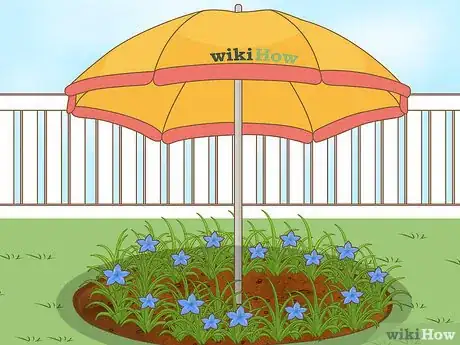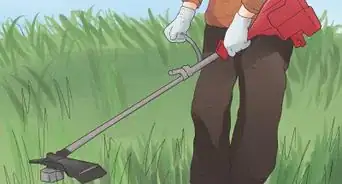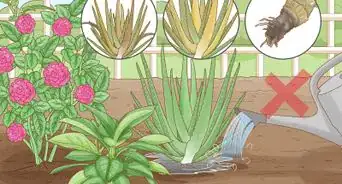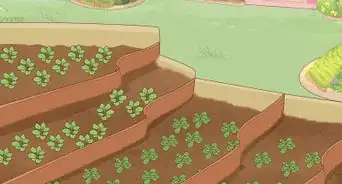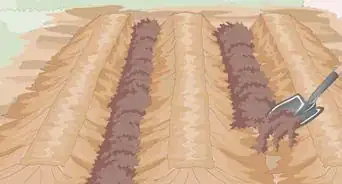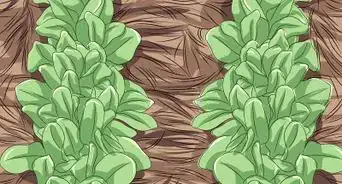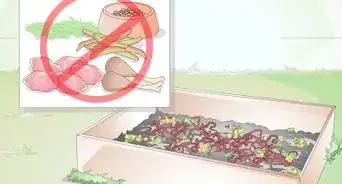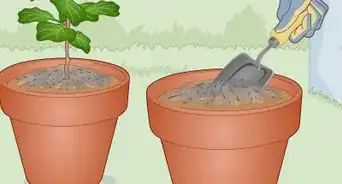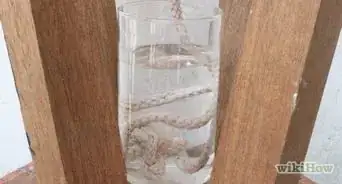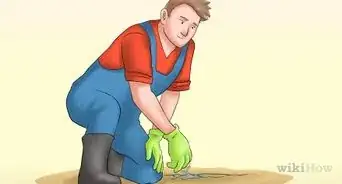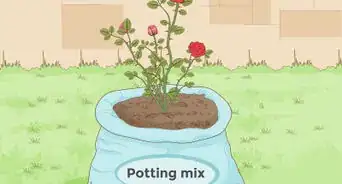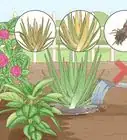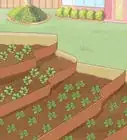This article was co-authored by Lauren Kurtz. Lauren Kurtz is a Naturalist and Horticultural Specialist. Lauren has worked for Aurora, Colorado managing the Water-Wise Garden at Aurora Municipal Center for the Water Conservation Department. She earned a BA in Environmental and Sustainability Studies from Western Michigan University in 2014.
This article has been viewed 121,978 times.
During the hot summer months, it can be difficult to keep the plants in your garden healthy, hydrated, and strong. Fortunately, there are several ways to keep your plants cool and properly hydrated. When the sun's beaming down, protect your garden by providing adequate moisture and shade.
Steps
Retaining Moisture
-
1Use irrigation hoses and soakers. When it’s really hot outside, the best way to effectively water your garden is by using irrigation or soaker hoses.[1] While these are slightly different from each other, they both deliver water slowly to the plants’ roots, which prevents evaporation and saves water.
- Irrigation hoses use flexible plastic tubing that contains little holes. Water slowly drips from these holes into the soil.
- Soaker hoses are made of a porous material that water seeps through.[2]
-
2Use a light mulch. Adding mulch to your garden will keep the soil protected from direct sun exposure and, as a result, allow the soil to stay moist for longer. You can use many different forms of mulch, but you’ll probably have the best results with a light-colored mulch, such as dried grass clippings, because it’ll reflect the sunlight.
- Use bark mulch around your shrubs.[3] Wood mulch is great because it will shade the soil from the sun and break down over time, adding compost to your soil.
Advertisement -
3Water your plants in the morning. During those hot summer months, it’s best to water your garden in the early morning before the sun starts beating down. If you wait until midday or even early afternoon, most of the water will likely evaporate before it travels to the plants’ roots.
- If you can’t water your plants in the morning, the early evening is another good time to water.[4]
-
4Water your garden with rainwater. Rainwater is a lot better for your plants than tap water because it contains all necessary natural minerals without any added chemicals. As a result, they’ll thrive better if watered this way, especially if they’re struggling in the heat.
- Consider installing a rainwater tank in order to collect enough rainwater to water your garden. These are relatively easy to install and are typically attached to your gutters.[5]
-
5Hand water your plants. If you don’t want to deal with irrigation or soaker hoses, opt for hand watering your plants. This is much better than relying on sprinklers because sprinklers can sufficiently water specific areas of your garden that are in range and leave others completely dry.[6]
-
6Keep your lawn 3-6 inches (7.62-15.24 cm) long. Longer grass can have a bit of a shading effect, which helps the soil retain moisture. In order for this to be effective, keep your grass at least 3 inches (7.62 cm) long. In extreme heat or during droughts, it’s best to have the grass closer to 6 inches (15.24 cm).[7]
-
7Avoid over-watering your garden. Heat and sun exposure can cause transpiration on your overwatered plants, which can lead to leaf wilt. Additionally, when plants are watered too much, the excessive moisture in the soil can cause bacteria to develop, oxygen to be in short supply, and ultimately create fungal disease. Resist the urge to water your plants too much when it’s really hot outside.[8]
- Your plants only really need to be watered if the soil is dry. To prevent overwatering, touch the soil to make sure it’s dry before you decide to water the garden.
-
8Weed your garden regularly. Pesky weeds that infest your garden can soak up all the water, leaving little for the plants in your garden that you want to keep nourished and hydrated. Weed your garden once a week for the best results, or twice a month at the bare minimum.[9]
Shading Your Garden
-
1Plant your garden in a shady area. If you live somewhere where the summers are scorching, then your garden should be located somewhere in the yard where there’s permanent shade. Start your garden close to the biggest tree in your yard or close to your house so that it’ll constantly be shaded.[10]
-
2Use shade covers. You can either buy a shade cover or cloth from a local garden center, or you can make your own. Old sheets, old window screens, or narrow panels of wood lattice can all effectively cover and cool the plants in your garden. However, make sure that the cover is kept at least several inches above the plants.
- If using a cloth cover, staple each end to stakes placed on either side of the garden.
- Ideally, covers should block about 50% of the sunlight.[11]
-
3Provide shade with a patio umbrella. Especially if your garden is smaller, placing a patio umbrella right next to the garden is a quick and easy way to provide some shade. Make sure to only do this if the umbrella shades your entire garden.[12]
-
4Build a snow fence. While snow fences are typically used to control where snow does and doesn’t accumulate, they can also do a great job of shading your garden in the summer time. Install a short section of snow fencing near your garden to provide a cooler environment for your plants.[13]
-
5Put transplants next to larger plants. Since transplants are younger and less established, they are even more susceptible to struggling in high heat. If at all possible, wait until the hot months of summer have passed before you move them to the garden. If you move your transplants to the garden when it’s really hot, make sure to put them in the shade of other larger plants. This will greatly help in protecting the transplants.[14]
Expert Q&A
Did you know you can get expert answers for this article?
Unlock expert answers by supporting wikiHow
-
QuestionWhy do plants wilt on a hot summer's day?
 Lauren KurtzLauren Kurtz is a Naturalist and Horticultural Specialist. Lauren has worked for Aurora, Colorado managing the Water-Wise Garden at Aurora Municipal Center for the Water Conservation Department. She earned a BA in Environmental and Sustainability Studies from Western Michigan University in 2014.
Lauren KurtzLauren Kurtz is a Naturalist and Horticultural Specialist. Lauren has worked for Aurora, Colorado managing the Water-Wise Garden at Aurora Municipal Center for the Water Conservation Department. She earned a BA in Environmental and Sustainability Studies from Western Michigan University in 2014.
Professional Gardener
-
QuestionWhat helps keep plants cool?
 Lauren KurtzLauren Kurtz is a Naturalist and Horticultural Specialist. Lauren has worked for Aurora, Colorado managing the Water-Wise Garden at Aurora Municipal Center for the Water Conservation Department. She earned a BA in Environmental and Sustainability Studies from Western Michigan University in 2014.
Lauren KurtzLauren Kurtz is a Naturalist and Horticultural Specialist. Lauren has worked for Aurora, Colorado managing the Water-Wise Garden at Aurora Municipal Center for the Water Conservation Department. She earned a BA in Environmental and Sustainability Studies from Western Michigan University in 2014.
Professional Gardener
-
QuestionCan you save a wilted plant?
 Lauren KurtzLauren Kurtz is a Naturalist and Horticultural Specialist. Lauren has worked for Aurora, Colorado managing the Water-Wise Garden at Aurora Municipal Center for the Water Conservation Department. She earned a BA in Environmental and Sustainability Studies from Western Michigan University in 2014.
Lauren KurtzLauren Kurtz is a Naturalist and Horticultural Specialist. Lauren has worked for Aurora, Colorado managing the Water-Wise Garden at Aurora Municipal Center for the Water Conservation Department. She earned a BA in Environmental and Sustainability Studies from Western Michigan University in 2014.
Professional Gardener If lack of water is the problem then yes, you can keep the plant's soil watered. If too much water is the problem, reduce watering and make sure your soil has good drainage. Plants can also wilt because of high temperatures or too much sun. Use a shade cloth to protect your plant from extreme temperatures.
If lack of water is the problem then yes, you can keep the plant's soil watered. If too much water is the problem, reduce watering and make sure your soil has good drainage. Plants can also wilt because of high temperatures or too much sun. Use a shade cloth to protect your plant from extreme temperatures.
Warnings
- Make sure to take good care of yourself when gardening in the heat. Work in short increments, avoid working during the hottest times of day, stay hydrated, and wear sunscreen.⧼thumbs_response⧽
References
- ↑ https://learn.eartheasy.com/articles/how-to-protect-your-garden-during-a-heat-wave/
- ↑ https://www.savingwater.org/lawn-garden/watering-irrigation/drip-irrigation-soaker-hoses/
- ↑ https://learn.eartheasy.com/articles/how-to-protect-your-garden-during-a-heat-wave/
- ↑ https://gardentherapy.ca/protect-plants-from-heat/
- ↑ http://www.homestolove.com.au/save-our-shrubs-how-to-care-for-plants-when-its-hot-1763
- ↑ https://learn.eartheasy.com/articles/how-to-protect-your-garden-during-a-heat-wave/
- ↑ https://learn.eartheasy.com/articles/how-to-protect-your-garden-during-a-heat-wave/
- ↑ https://gardentherapy.ca/protect-plants-from-heat/
- ↑ http://www.homestolove.com.au/save-our-shrubs-how-to-care-for-plants-when-its-hot-1763
- ↑ http://www.homestolove.com.au/save-our-shrubs-how-to-care-for-plants-when-its-hot-1763
- ↑ http://www.motherearthnews.com/organic-gardening/keeping-crops-cool-during-hot-weather-zmaz08aszgoe
- ↑ https://gardentherapy.ca/protect-plants-from-heat/
- ↑ http://www.motherearthnews.com/organic-gardening/keeping-crops-cool-during-hot-weather-zmaz08aszgoe
- ↑ https://learn.eartheasy.com/articles/how-to-protect-your-garden-during-a-heat-wave/
About This Article
During harsh summers, you’ll need to keep your garden cool and hydrated. Use an irrigation or soaker hose to water your garden efficiently. Water your plants in the early morning so the moisture has time to reach their roots before it evaporates. However, if the soil is still moist, leave it alone to avoid saturating your plants. To protect your plants from the sun’s heat, place shade covers or patio umbrellas over them. You can also lay a light mulch, like dried clippings or bark chips, over the soil to protect it. For more tips from our Gardening co-author, including how to shade your garden with fencing, read on!










